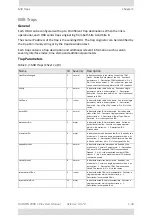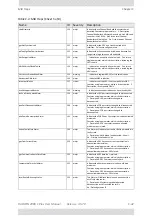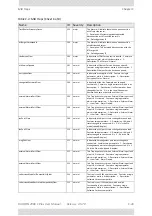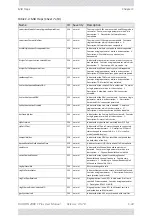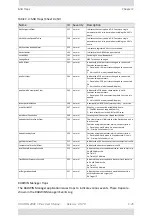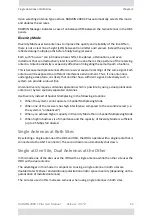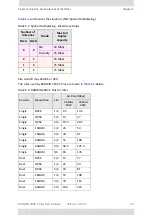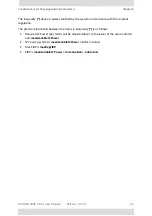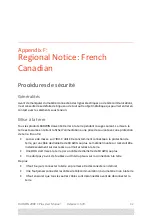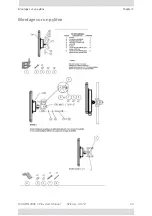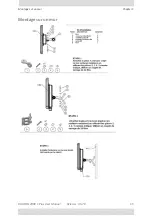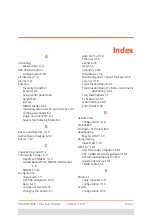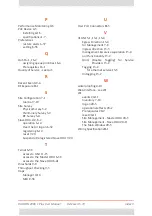
RADWIN
2000
C
Plus
User
Manual
Release
3.5.70
E
‐
2
Single
Antennas
at
Both
Sites
Chapter
E
Upon
selecting
Antenna
Type
as
Dual,
RADWIN
2000
C
Plus
automatically
selects
this
mode
and
doubles
the
air
rates.
RADWIN
Manager
indicates
a
case
of
unbalanced
RSS
between
the
two
antennas
in
the
HBS
panels.
Diversity
Mode
Diversity
Mode
uses
two
antennas
to
improve
the
quality
and
reliability
of
the
link.
Often,
there
is
not
a
clear
line
‐
of
‐
sight
(LOS)
between
transmitter
and
receiver.
Instead
the
signal
is
reflected
along
multiple
paths
before
finally
being
received.
Each
such
“bounce”
can
introduce
phase
shifts,
time
delays,
attenuations,
and
even
distortions
that
can
destructively
interfere
with
one
another
at
the
aperture
of
the
receiving
antenna.
Antenna
diversity
is
especially
effective
at
mitigating
these
multi
‐
path
situations.
This
is
because
multiple
antennas
afford
a
receiver
several
recordings
of
the
same
signal.
Each
antenna
will
be
exposed
to
a
different
interference
environment.
Thus,
if
one
antenna
is
undergoing
a
deep
fade,
it
is
likely
that
another
has
a
sufficient
signal.
Collectively
such
a
system
can
provide
a
robust
link.
Antenna
diversity
requires
antenna
separation
which
is
possible
by
using
a
dual
‐
polarization
antenna
or
by
two
spatially
separated
antennas.
Use
Diversity
instead
of
Spatial
Multiplexing
in
the
following
situations:
•
When
the
system
cannot
operate
in
Spatial
Multiplexing
Mode
•
When
one
of
the
receivers
has
high
interference
compared
to
the
second
receiver
(i.e.
the
system
is
“unbalanced”)
•
When
you
achieve
higher
capacity
in
Diversity
Mode
than
in
Spatial
Multiplexing
Mode
•
When
high
robustness
is
of
importance
and
the
capacity
of
Diversity
Mode
is
sufficient
(up
to
25
Mbps
full
duplex)
Single
Antennas
at
Both
Sites
By
selecting
a
single
antenna
at
the
HBS
and
HSU,
the
ODUs
operate
with
a
single
radio
that
is
connected
to
the
ANT
1
connector.
The
second
radio
is
automatically
shut
down.
Single
at
One
Site,
Dual
Antennas
at
the
Other
In
this
mode
one
of
the
sites
uses
the
ODU
with
a
single
antenna
while
the
other
site
uses
the
ODU
with
a
dual
antenna.
The
advantages
in
this
mode
in
comparison
to
using
a
single
antenna
in
both
sites
are
doubled
total
Tx
Power
and
additional
polarization
and/or
space
diversity
(depending
on
the
polarization
of
installed
antennas).
The
air
rates
used
in
this
mode
are
same
as
when
using
single
antennas
in
both
sites.
Summary of Contents for 2000 C PLUS
Page 1: ...USER MANUAL RADWIN 2000 C PLUS POINT TO POINT BROADBAND WIRELESS Release 3 5 70...
Page 17: ...Part 1 Basic Installation Release 3 5 70...
Page 139: ...Part 2 Site Synchronization Release 3 5 70...
Page 166: ...Part 3 Advanced Installation Topics Release 3 5 70...
Page 167: ...RADWIN 2000 C Plus User Manual Release 3 5 70 12 1 Chapter 12 Reserved...
Page 188: ...RADWIN 2000 C Plus User Manual Release 3 5 70 17 1 Chapter 17 Reserved...
Page 189: ...Part 4 Field Installation Topics Release 3 5 70...
Page 219: ...Part 5 Product Reference Release 3 5 70...
Page 296: ......



